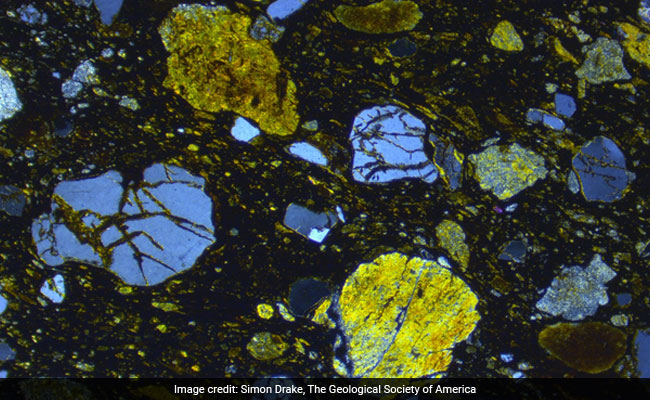
This is the first meteorite impact described within the British Paleogene Igneous Province.
London:
Geologists exploring volcanic rocks on Scotland's Isle of Skye have found ejecta from a previously unknown, 60 million-year-old meteorite impact.
The discovery, the first meteorite impact described within the British Paleogene Igneous Province (BPIP), raises questions about the impact and its possible connection to Paleogene volcanic activity across the North Atlantic.
Simon Drake, an associate lecturer in geology at Birkbeck University of London, zeroed in on a meter-thick layer at the base of a 60.0 million-year-old lava flow.
"We thought it was an ignimbrite (a volcanic flow deposit)," said Drake.
However, when researchers analysed the rock using an electron microprobe, they discovered that it contained rare minerals straight from outer space: vanadium-rich and niobium-rich osbornite.
These mineral forms have never been reported on Earth.They have, however, been collected by NASA's Stardust Comet Sample Return Mission as space dust in the wake of the Wild 2 comet, researchers said.
What is more, the osbornite is unmelted, suggesting that it was an original piece of the meteorite.
The team also identified reidite, an extremely high pressure form of zircon which is only ever associated in nature with impacts, along with native iron and other exotic mineralogy linked to impacts such as barringerite.
 A second site, seven kilometres away, proved to be a two-meter-thick ejecta layer with the same strange mineralogy.
A second site, seven kilometres away, proved to be a two-meter-thick ejecta layer with the same strange mineralogy.
In the research published in the journal Geology, the researchers pin the impact to sometime between 60 million and 61.4 million years ago (Ma), constrained by a 60 Ma radiometric age for the overlying lava flow, and 61.4 Ma for a basalt clast embedded within the ejecta layer.
So far, Drake has collected samples from another site on Skye that also yield strange mineralogy, including another mineral strikingly similar to one found in comet dust.
He said that it was surprising that the ejecta layer had not been identified before, as the Isle of Skye is famously well-trampled by geologists.
The discovery, the first meteorite impact described within the British Paleogene Igneous Province (BPIP), raises questions about the impact and its possible connection to Paleogene volcanic activity across the North Atlantic.
Simon Drake, an associate lecturer in geology at Birkbeck University of London, zeroed in on a meter-thick layer at the base of a 60.0 million-year-old lava flow.
"We thought it was an ignimbrite (a volcanic flow deposit)," said Drake.
However, when researchers analysed the rock using an electron microprobe, they discovered that it contained rare minerals straight from outer space: vanadium-rich and niobium-rich osbornite.
These mineral forms have never been reported on Earth.They have, however, been collected by NASA's Stardust Comet Sample Return Mission as space dust in the wake of the Wild 2 comet, researchers said.
What is more, the osbornite is unmelted, suggesting that it was an original piece of the meteorite.
The team also identified reidite, an extremely high pressure form of zircon which is only ever associated in nature with impacts, along with native iron and other exotic mineralogy linked to impacts such as barringerite.

Thin section view of meteoritic ejecta deposit.
In the research published in the journal Geology, the researchers pin the impact to sometime between 60 million and 61.4 million years ago (Ma), constrained by a 60 Ma radiometric age for the overlying lava flow, and 61.4 Ma for a basalt clast embedded within the ejecta layer.
So far, Drake has collected samples from another site on Skye that also yield strange mineralogy, including another mineral strikingly similar to one found in comet dust.
He said that it was surprising that the ejecta layer had not been identified before, as the Isle of Skye is famously well-trampled by geologists.

